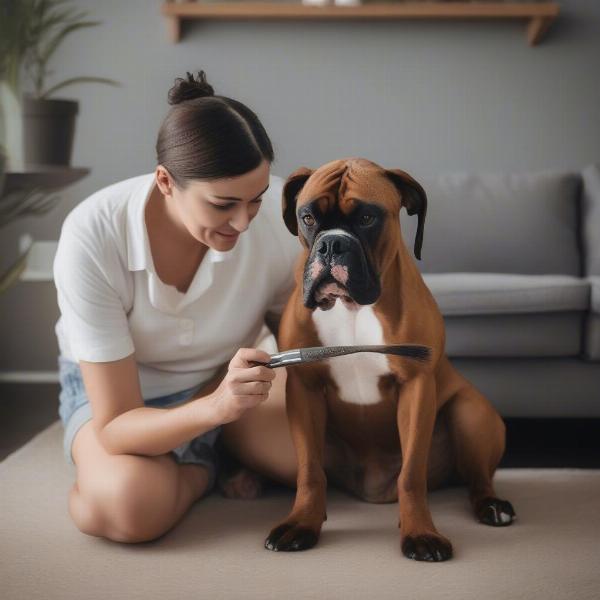Reverse brindle dogs possess a fascinating coat pattern that often sparks curiosity. Unlike the typical brindle pattern with darker stripes on a lighter base, a reverse brindle displays lighter stripes on a darker background. This intriguing variation raises questions about genetics, breed prevalence, and whether it signifies anything special about the dog’s temperament or health. This article delves into the world of reverse brindle dogs, exploring the science behind this distinctive coat, the breeds where it’s most commonly observed, and what it means for dog owners.
Decoding the Reverse Brindle Genetics
The brindle pattern itself arises from the interaction of the Kbr and Agouti genes. The Kbr gene is responsible for the brindle striping, while the Agouti gene influences the distribution of pigment in the hair shaft. In a reverse brindle, the lighter stripes are thought to be caused by a modification in the Agouti gene expression, leading to reduced pigment deposition in specific areas. It’s a complex genetic dance that results in this striking reversal of the typical brindle appearance.
While the exact mechanisms are still being studied, the inheritance of the reverse brindle pattern is believed to be recessive. This means both parents must carry the gene for a reverse brindle puppy to be born. Even then, not all puppies in a litter will exhibit the reverse brindle pattern, highlighting the fascinating complexity of canine genetics.
Breeds Prone to Reverse Brindle
Although the reverse brindle pattern can theoretically occur in any breed that carries the brindle gene, it’s more commonly observed in certain breeds. Boxers, Great Danes, and Bulldogs are among the breeds where reverse brindle is more frequently seen. Other breeds like Mastiffs, Whippets, and even French Bulldogs have also been known to occasionally sport this unique coat pattern. It’s worth noting that the intensity and clarity of the reverse brindle pattern can vary significantly even within the same breed.
Does Reverse Brindle Affect Temperament or Health?
The reverse brindle pattern is purely cosmetic and doesn’t influence a dog’s temperament or health. Just like a standard brindle, a reverse brindle dog can be playful, affectionate, energetic, or calm depending on its breed, individual personality, and upbringing. It’s essential to remember that coat color is not a predictor of behavior or health conditions.
Caring for a Reverse Brindle Dog
Caring for a reverse brindle dog is no different from caring for any other dog with a similar coat type. Regular brushing is crucial to maintain a healthy and shiny coat, preventing matting and removing loose hair. Bathing should be done as needed, using a gentle dog shampoo to avoid stripping the natural oils from the coat. A balanced diet, regular exercise, and routine veterinary checkups are essential for the overall well-being of any dog, regardless of its coat color.
 Reverse Brindle Dog Care
Reverse Brindle Dog Care
Conclusion: Embracing the Uniqueness of Reverse Brindle
The reverse brindle pattern adds a touch of mystique and individuality to a dog’s appearance. It’s a testament to the fascinating diversity within canine genetics. Whether you’re captivated by the science behind the pattern or simply appreciate its aesthetic appeal, remember that a reverse brindle dog is just as lovable and deserving of care as any other dog. Embrace their unique beauty and provide them with the love and attention they deserve.
FAQ
- What causes the reverse brindle pattern? The reverse brindle pattern is a result of the interaction between the Kbr and Agouti genes, resulting in lighter stripes on a darker background.
- Is reverse brindle rare? While not exceptionally rare, it’s less common than the standard brindle pattern.
- What breeds are known to have reverse brindle coats? Boxers, Great Danes, and Bulldogs are among the breeds where it’s most frequently seen.
- Does reverse brindle affect a dog’s personality? No, coat color does not influence a dog’s temperament.
- Does a reverse brindle dog require special care? No, their care is similar to any other dog with a similar coat type.
Related Articles on ILM Dog
About ILM Dog
ILM Dog (ILM Dog) is your trusted source for comprehensive information on dog breeds, health, training, nutrition, grooming, and much more. We offer expert advice and resources to help you provide the best possible care for your canine companion. Our expertise encompasses breed selection, health and medical care, training techniques, and optimal nutrition strategies. For any questions or inquiries, feel free to reach out to us via email at [email protected] or phone at +44 20-3965-8624.